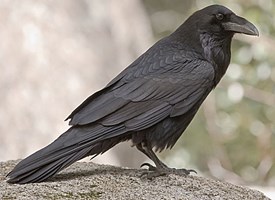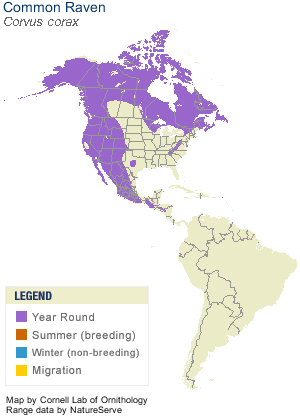 |
Canku Ota
|
 |
|
(Many Paths)
|
||
|
An Online Newsletter
Celebrating Native America
|
||
|
December 2017 - Volume
15 Number 12
|
||
|
|
||
|
Common Raven
Corvus corax |
||
|
by Cornell Lab of Ornithology
|
||
|
At a Glance
Cool Facts
Common Ravens occur over most of the Northern Hemisphere in nearly any habitat (eastern forests and the open Great Plains are exceptions). These include coniferous and deciduous forests, beaches, islands, chaparral, sagebrush, mountains, desert, grasslands, agricultural fields, tundra, and ice floes. They do well around human habitations including farms, rural settlements and isolated houses. In larger towns they are often replaced by American Crows, although they do occur in some cities including Los Angeles. Human presence has allowed ravens to expand into areas where they didn’t previously occur, such as using artificial ponds and irrigation to survive in deserts and living on human garbage in some forests. Common Ravens are slowly moving back into the forests of the northeastern United States and Canada as those forests regenerate.
Common Ravens will eat almost anything they can get hold of. They eat carrion; small animals from the size of mice and baby tortoises up to adult Rock Pigeons and nestling Great Blue Herons; eggs; grasshoppers, beetles, scorpions, and other arthropods; fish; wolf and sled-dog dung; grains, buds, and berries; pet food; and many types of human food including unattended picnic items and garbage.
Nesting Nest Description Males bring some sticks to the nest, but most of the building is done by females. Ravens break off sticks around 3 feet long and up to an inch thick from live plants to make up the nest base, or scavenge sticks from old nests. These sticks, and sometimes bones or wire as well, are piled on the nest platform or wedged into a tree crotch, then woven together into a basket. The female then makes a cup from small branches and twigs. The cup bottom is sometimes lined with mud, sheep’s wool, fur, bark strips, grasses, and sometimes trash. The whole process takes around 9 days, resulting in an often uneven nest that can be 5 feet across and 2 feet high. The inner cup is 9-12 inches across and 5-6 inches deep. Nests are often reused, although not necessarily by the same birds, from year to year.
Common Ravens build their nests on cliffs, in trees, and on structures such as power-line towers, telephone poles, billboards, and bridges. Cliff nests are usually under a rock overhang. Tree nests tend to be in a crotch high in the tree, but below the canopy and typically farther down in a tree than a crow’s nest would be.
Common Ravens are so bold, playful, and clever that they’re almost always doing something worth watching. They’re less gregarious than crows, often seen alone or in pairs that stay together year round, although many may gather at a carcass or landfill. Large groups of ravens are probably young birds that have yet to pair up; ravens begin breeding at ages 2 to 4. On the ground ravens walk confidently, sometimes with a swagger, sometimes sidling. In flight they’re more graceful and agile than crows, which often appear to be swimming across the sky compared to a raven’s light wingbeats and occasional soaring. Ravens often perform aerobatics, including sudden rolls, wing-tucked dives, and playing with objects by dropping and catching them in midair. Known for their intelligence, Common Ravens can work together to solve novel problems. They sometimes follow people and possibly female cowbirds to find nests to raid. (Ravens have followed researchers as they set up artificial nests, raiding them soon after the researchers left.) Young ravens just out of the nest pick up and examine almost anything new they run across as they learn what’s useful and what isn’t. Ravens that find a big food supply (such as a large carcass or unguarded seabird nests) often cache some for later, the way other crows and jays store seeds.
Common Raven populations increased across the continent between 1966 and 2014, according to the North American Breeding Bird Survey. Partners in Flight estimates their global breeding population to be 20 million with 18% living in Canada, 9% in the U.S., and 3% in Mexico. They rate a 6 out of 20 on the Continental Concern Score and are not on the 2014 State of the Birds Watch List. Common Ravens tend to do well around people, profiting from the garbage, crops, irrigation, and roadkill that accompany us. Their numbers are generally stable or rising in western North America. As eastern forests were cut down in the nineteenth and twentieth centuries ravens disappeared from most of eastern North America, but they are beginning to return to the Northeast as forest cover regenerates. In many situations ravens are unwelcome: they have been shot at, poisoned, or harassed in attempts to preserve crops (and occasionally livestock such as lambs). Ravens sometimes prey on threatened species, including Least Terns, Marbled Murrelets, and desert tortoises, and wildlife biologists have spent a lot of effort and ingenuity in trying to thwart ravens to help those species, with mixed success. |
||||||||||||||||||||||||||||||||
|
|
|
||
|
|
||
| Canku Ota is a free Newsletter celebrating Native America, its traditions and accomplishments . We do not provide subscriber or visitor names to anyone. Some articles presented in Canku Ota may contain copyright material. We have received appropriate permissions for republishing any articles. Material appearing here is distributed without profit or monetary gain to those who have expressed an interest. This is in accordance with Title 17 U.S.C. Section 107. | ||
|
Canku Ota is a copyright ©
2000 - 2017 of Vicki Williams Barry and Paul Barry.
|
||
 |
 |
|
|
The "Canku
Ota - A Newsletter Celebrating Native America" web site and
its design is the
|
||
|
Copyright ©
1999 - 2017 of Paul C. Barry.
|
||
|
All Rights Reserved.
|
||
 The
intriguing Common Raven has accompanied people around the Northern
Hemisphere for centuries, following their wagons, sleds, sleighs,
and hunting parties in hopes of a quick meal. Ravens are among the
smartest of all birds, gaining a reputation for solving ever more
complicated problems invented by ever more creative scientists.
These big, sooty birds thrive among humans and in the back of beyond,
stretching across the sky on easy, flowing wingbeats and filling
the empty spaces with an echoing croak.
The
intriguing Common Raven has accompanied people around the Northern
Hemisphere for centuries, following their wagons, sleds, sleighs,
and hunting parties in hopes of a quick meal. Ravens are among the
smartest of all birds, gaining a reputation for solving ever more
complicated problems invented by ever more creative scientists.
These big, sooty birds thrive among humans and in the back of beyond,
stretching across the sky on easy, flowing wingbeats and filling
the empty spaces with an echoing croak.




